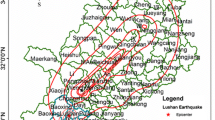Abstract
The Yushu Ms 7.1 earthquake occurred on April 14, 2010 in Qinghai Province, China. It induced a mass of secondary geological disasters, such as collapses, landslides, and debris flows. Risk assessment maps are important for geological disaster prevention and mitigation, and also can serve as a guide for post-earthquake reconstruction. Firstly, a hazard assessment index system of secondary geological disasters in the earthquake region was built in this paper, which was based on detailed analysis of environmental and triggering factors closely related to geological disasters in the study area. GIS technology was utilized to extract and analyze the assessment index. Hazard assessment maps of secondary geological disasters were obtained by spatial modeling and overlaying analysis. Secondly, an analysis of the vulnerability of hazard bearing bodies in the area was conducted, important information, such as, population density, percentage of arable land, industrial and agricultural outputs per unit area were regarded as assessment indices to evaluate socioeconomic vulnerability. Thirdly, the risk level of secondary geological disasters of the area was obtained by the formula: Risk=Hazard × Vulnerability. Risk assessment maps were categorized into four levels, including “low”, “moderate”, “high” and “very high”. These results show that some urban areas are at very high risk, including Jiegu, Chengwen, Xiaxiula and Sahuteng towns. This research can provide some references and suggestions to improve decision-making support for emergency relief and post-earthquake reconstruction in the study area.
Similar content being viewed by others
References
Anbalagan R (1992) Landslide hazard evaluation and zonation mapping in mountainous terrain. Engineering Geology 32: 269–277.
Chen JP, Li JF, Qin XW, et al. (2009a) RS and GIS-based statistical analysis of secondary geological disasters after the 2008 Wenchuan earthquake. Acta Geologica Sinica 83(4): 776–785.
Chen XL, Ran HL, Qi SW (2009b) Triggering factors susceptibility of earthquake-induced landslides in 1976 Longling earthquake. Acta Scientiarum Naturalium Universitatis Pekinensis 45(1):104–110.
Dong Y (2009) Theroy and Practice of Geological disaster Risk Assessment. Beijing: Geological Publishing House. pp 67–70. (In Chinese)
Du J, Yang QH, Yan J, et al. (2010) Hazard evaluation of secondary geological disaster based on GIS and information value method. Earth Science (Journal of China University of Geosciences) 35(2): 324–330.
Eidenshink JC (1992) The 1990 conterminour U.S. AVHRR dataset. Photogrammetric Engineering and Remote sensing 58(6): 809–813.
Fan J (2010) Yushu Earthquake Post-disaster Reconstruction and Resources & Environmental Capacity Evaluation. Beijing: Science Press. pp 23–61. (In Chinese)
Greco R, Sorriso-Valvo M, Catalano E (2007) Logistic regression analysis in the evaluation of mass movements susceptibility: The Aspromonte case study, Calabria, Italy. Engineering Geology 89: 47–66.
Hang RQ, Li WL (2008) Research on development and distribution rules of geohazards induced by Wenchuan earthquake on 12th May, 2008. Chinese Journal of Rock Mechanics and Engineering 27(12): 2585–2592.
Huang RQ, Li WL (2009) Fault effect analysis of geo-hazard triggered by Wenchuan earthquake. Journal of Engineering Geology 17(1):19–28.
King RW, Shen F, Burchfiel BC, et al. (1997) Geodetic measurement of crustal motion in Southwest China. Geology 25: 179–l82.
Lin AW (1992) The research on fault structure in the Wuhan area. Journal of Wuhan Technical University of Surveying and Mapping 17(3): 69–76.
Lin ML, Tung CC (2003) A GIS-based potential analysis of the landslides induced by the Chi-Chi earthquake. Engineering Geology 71(1–2): 63–77.
Liu FM, Zhang LH, Liu HQ, et al. (2006) Danger assessment of earthquake-induced geological disasters in China. Journal of Geomechanics 12(2): 127–131.
Liu HJ, Lan HX, Chen WM (2010) Numeric simulation for group-occurring debris flows and its risk analysis in Jiegu township after the earthquake of Yushu Qinghai province. Journal of Mountain Science 28(4): 444–452.
Qi SW, Xu Q, Liu CL, et al. (2009) Slope instabilities in the severest disaster Areas of 5.12 Wenchuan earthquake. Journal of Engineering Geology 17(1): 39–49.
Ruan SY, Huang RQ (2001) Application of GIS-based information model on assessment of geological hazards risk. Journal of Chengdu University of Technology 28(1): 89–92.
Sun CS, Cai HW (1997) Developing and distributing characteristics of collapses and landslides during strong historic earthquake in China. Journal of Natural Disasters 6(1):25–30.
Tang HM, Lin XS, Chen HK, et al. (2004) Risk zoning assessment of geological disaster in Wanzhou area, Chongqing City. The Chinese Journal of Geological Hazard and Control 15(3): 1–5.
Varnes DJ (1984) Landslide Hazard Zonation: A Review of Principle and Practice. Paris: UNESCO.
Wei CJ, Liu YL, Wang SX, et al. (2008) Investigation and assessment of damage in earthquake Wenchuan Sichuan quake based on remote sensing. Journal of Remote Sensing 12(5): 673–682.
Xiao HB, Cairen ZX, Gele BD, et al. (2005) Analysis for reason of debris flow of north hillside of Yushu Jiegu Town in 2003.7.29. Qinhai Science and Technology 12(1): 37–39. (In Chinese)
Zhang YS, Lei WZ, Shi JS, et al. (2008) General characteristics of 5.12 earthquake-induced geohazards in Sichuan. Journal of Geomechanics 14(2): 109–116.
Zhang CS, Zhang YC, Hu JJ (2000) Spatial and temporal distribution characteristics and forming conditions of Chinese geological disasters. Quaternary Sciences 20(6): 559–565.
Author information
Authors and Affiliations
Corresponding author
Rights and permissions
About this article
Cite this article
Niu, Q., Cheng, W., Liu, Y. et al. Risk assessment of secondary geological disasters induced by the Yushu earthquake. J. Mt. Sci. 9, 232–242 (2012). https://doi.org/10.1007/s11629-012-2076-4
Received:
Accepted:
Published:
Issue Date:
DOI: https://doi.org/10.1007/s11629-012-2076-4




